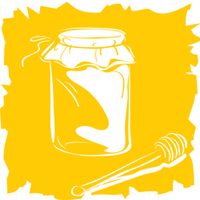Рецепт Sourdough Bread, How To (Part 1 Of 2)
Порций: 1
Ингредиенты
- Â Â HOW TO BAKE A LOAF OF SOURDOUGH BREAD
Инструкции
- "Lets face it, this is baking, not microbiology, rocket science, or possibly voodoo!
- We all do it because it's fun and challenging. No one who owns a computer is baking their own bread because they have to." Buddy
- This is a short, simple "how to" for sourdough newbies. The FAQs are overwhelming to those who have barely baked a loaf of yeast bread. I hate to see people get discouraged and give up on sourdough and hope this will prevent which.
- INDEXGLOSSARYGET A STARTERSTARTER RECIPEBAKE BREADKNEADING, RISING, EXPANDING AND DOUBLING YEAST IN THE BREAD RECIPE
- EXPAND SOURDOUGH BY FEEDING SOURDOUGH STARTER BAKE BREADSUGAR
- HOW LONG CAN YOU FORGET STARTER IN THE REFRIGERATOR DRYING STARTERRESTORING Dry STARTERADDING STUFF TO BREADBAKING STONESGLOSSARYTo give you a hand with terms in the long FAQs, here are various meanings and definitions that a couple people were considerate sufficient to send to me. Thanks to Jeff Renner and Bob Batts.
- FERMENTING: before dough is shaped
- PROOFING: after dough is shaped
- RETARDED: dough placed in refrigerator or possibly cool environment to slow proofing
- STARTER: "what's in the refrigerator"
- SPONGE: starter mixed with flour and water
- 'BATTER,' 'STARTER,' AND 'SPONGE': the stage "before ingredients other than flour and water are added." The three terms are used interchangeably.
- SPONGE: "a thicker dough in preparation for making bread"
- BATTER: dough in preparation for making pancakes (thinner than "sponge")
- Bob Batts sent this helpful paragraph: "I think which on this group
- (rec.food.sourdough) ..., we most often called what we keep from batch to batch the starter or possibly culture, the next stage the sponge. We have often used the terms building or possibly doubling rather than expanding, although you can certainly triple or possibly quadruple an active sponge."
- I use the following terms:SOURDOUGH STARTER: the flour and water mix I keep in the refrigerator
- EXPANDED SOURDOUGH: The night before I bake bread, I take the starter out of the refrigerator and add in flour and water to it. It sits overnight and expands. In the morning, it's bubbly and lively-looking. It does look like a sponge, but which's something you clean the bathtub with! Anyway, part of this goes into your bread dough and some ALWAYS goes back into the refrigerator.
- DOUGH: Expanded sourdough plus other recipe ingredients such as sugar, butter, oat bran, the roaches which fell into the expanding sourdough the night before, etc.
- BREAD: baked doughGET A STARTERA starter can be started from scratch, received wet or possibly dry from a friend, or possibly purchased.
- If you cannot get one from someone and do not want to buy one, a simple recipe follows. Yes, it has yeast and sugar . . . which's ok.
- If you want to stay "pure," someone who I asked to critique this document suggested reading Nancy Silverton's "The La Brea Bakery." He said,
- "She has a very involved recipe for making a starter and is death on any type of commercial yeast in a starter (she uses grapes in her starter for natural fermentation)."I'm trying to keep this simple and I'd suggest the newbie get a few loaves under their belt the easy way first.
- BAKE BREADOnce your starter is established, the basic steps are: 1. remove starter from refrigerator and feed it flour and water
- 2. let starter sit overnight and expand
- 3. remove the amount of starter needed for the bread recipe (NEVER all of it)
- 4. return what remains (and some always must) of the expanded starter to refrigerator
- 5. mix a bread recipe
- 6. bake bread
- 7. eat bread
- 8. return to step 1 when bread is gone : )
- Try a one-loaf recipe first. If it doesn't rise, add in yeast. But if the starter is bubbling, it should rise.
- Find any sourdough recipe and use the required amount of expanded starter. Do not use all the starter! Be sure you keep some of it to expand the next time you want to bake.
- KNEADING, RISING, EXPANDING AND DOUBLING Knead your dough till it feels like a baby's bottom. If you do not know what which feels like, I'm so sorry. (This would be a freshly bathed, dry baby.)
- Doubling refers to the increase in volume of the bread recipe
- (dough). Completely mix the recipe. Let it double in size, then shape it into loaves. Let the loaves double in size before you bake them.
- NOTE WELL: Sourdough bread dough won't rise as quickly as yeast bread doughs. Give it as much as four hrs. Rising time will vary depending on the weather, humidity, how often you bake, the temperature of your house, etc.
- On a cool day, or possibly if your house is cold, speed the rising process for both starter and dough by letting it rise in the oven. Turn the oven to 200 degrees for 2 min; turn it off; check the temperature and make sure it's not higher than 100 degrees; put the starter or possibly dough in the oven (in a bowl which will not burn, covered with aluminum foil, in case someone comes along and turns the oven on without looking in the oven). Turning on the oven light can also hot the oven sufficient to get the stuff rising well. Use a huge bowl if you try this with your expanding starter. You do not want a mess in your oven from overflow!
- Postings to this newsgroup have stated which a long rise will increase the sour taste of your bread.
- Cover dough rising on the counter with a dish towel to prevent the crust from drying out.



